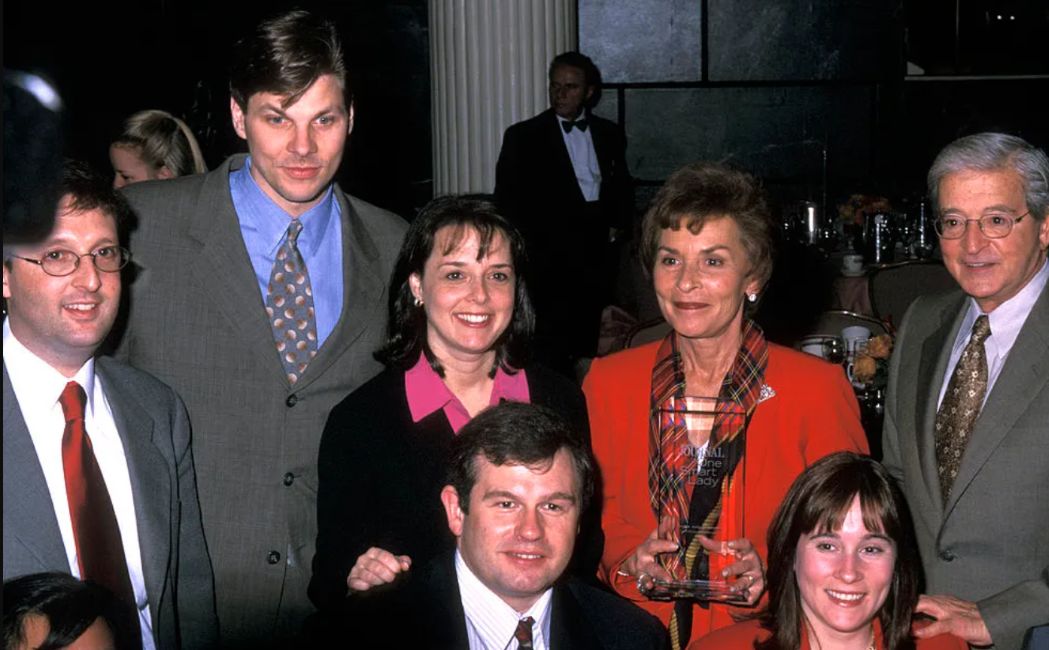Judge Jonathan Sheindlin: Divorce Court & More!
Who was the prominent legal commentator and television personality known for his courtroom shows? A celebrated figure in the legal and entertainment realms.
This individual was a highly visible figure in American popular culture, noted for his role as a judge on a long-running television program that featured courtroom proceedings. The show, known for its dramatic confrontations and legal interpretations, captured significant viewership.
The program's enduring popularity likely stemmed from a combination of factors, including the compelling nature of the legal cases presented, the personality of the judge, and the format's ability to engage a broad audience. Such programs, often featuring legal scenarios, can serve as a way to understand aspects of the legal process and to consider the societal implications of legal decisions.
| Category | Detail |
|---|---|
| Full Name | Jonathan Sheindlin |
| Occupation | Judge, Television Personality |
| Notable Works | Judge Judy |
| Known For | Legal commentary, courtroom television |
Further exploration into this figure's career and impact would delve into the specific legal cases featured, the cultural impact of the show, and the broader discussion of the role of legal figures in media. A more comprehensive treatment could examine the show's influence on popular perceptions of the legal system.
Jonathan Sheindlin
This individual's career as a legal commentator and television personality holds significance due to its substantial impact on popular culture and perceptions of the legal system.
- Judge
- Television
- Courtroom
- Legal
- Personality
- Controversies
The key aspects of Jonathan Sheindlin's career reveal a complex figure. His role as a judge on a popular television show exemplified a unique blend of legal proceedings and entertainment. This combination likely resonated with a broad audience. However, his methods and pronouncements sparked debate and controversy. While providing a platform for legal cases, his judgments and presentation style also generated significant discussion about the portrayal of the legal process in media. The aspect of controversies demonstrates the critical evaluation required when examining public figures.
1. Judge
The title "Judge" is central to understanding Jonathan Sheindlin's public persona and career trajectory. It signifies a specific role within the legal system, carrying inherent authority and responsibilities. Exploring this role provides insight into the nature of the television program, its impact, and the public perception of legal processes mediated through the figure of a judge.
- Authority and Jurisdiction
The position of Judge inherently entails authority, a power to make binding decisions. In the context of a television program, this authority is manifested in the rulings and judgments delivered by the individual. The implications of this authority extend to influencing public perceptions of legal matters and outcomes. The specific scope of authority exercised within the show's format should be considered, including the extent of discretion afforded to the judge.
- Decision-Making Process
A judge's role involves applying relevant laws and procedures to individual cases. The process of making decisions, including evidence evaluation and legal interpretation, has implications for the portrayal of the justice system. This process, often observed through the media, might shape public understanding of legal proceedings.
- Impartiality and Fairness
The ideal of judicial impartiality is a cornerstone of the legal system. The expectation is for judges to consider evidence fairly and apply laws without personal biases. The perceived level of impartiality in the figure of a judge, especially in a televised setting, has a significant impact on public trust and confidence in legal outcomes. Public perception of this impartiality, and potential perceived biases, in the context of this individual should be analyzed.
- Public Representation of the Law
The figure of a judge, particularly when presented through media, plays a role in shaping public understanding of legal principles and the legal system. The individual's decisions, rulings, and courtroom demeanor offer a particular presentation of the law to the public. This presentation should be evaluated in terms of its perceived accuracy and impact.
In conclusion, the multifaceted role of "Judge" within Jonathan Sheindlin's career encompasses significant aspects of legal authority, decision-making, impartiality, and public representation of the law. Further examination of these facets is necessary to fully appreciate the multifaceted influence and impact of this figure.
2. Television
Television played a pivotal role in Jonathan Sheindlin's career. The medium provided a platform for the dissemination of his legal expertise and personality to a vast audience. His show leveraged the reach and accessibility of television to present courtroom proceedings in a highly visible format, often employing dramatic presentation to engage viewers.
The success of the show can be attributed to several factors. High production values and compelling narratives created a compelling visual spectacle. The format also capitalised on viewers' interest in observing and interpreting legal cases, providing a readily accessible window into the workings of the legal system. This combination of factors fostered significant viewership, leading to substantial audience engagement and impacting public perception of courtroom proceedings.
The impact of television on Sheindlin's career was profound. It translated legal proceedings into a readily consumable form for viewers, cultivating a wider audience for legal topics. However, it also presented the challenge of presenting complex legal issues in a concise and engaging format, requiring a careful balance between accessibility and accuracy. The show's enduring popularity highlights the medium's capacity to elevate specific individuals and concepts into cultural touchstones.
3. Courtroom
The courtroom served as the central setting for Jonathan Sheindlin's career. It was the locus of his legal pronouncements, the stage for his judgments, and the context through which his public persona was formed and perceived. His show, heavily reliant on the courtroom environment, created a specific, recognizable narrative arc: cases were presented, evidence was assessed, rulings were delivered, often with dramatic effect. This format, built around the courtroom, became a hallmark of the program's identity.
The prominence of the courtroom in the program's structure influenced public perception of the legal system. The controlled environment of a courtroom, despite its complexities, presented a simplified view of the judicial process, often highlighting specific legal principles in a readily digestible format. However, this simplification, while effective for audience engagement, might have obscured the complexities of real-world legal systems. The courtroom's portrayal served as a mediated experience, filtering legal realities through a specific narrative. Specific examples, such as the manner in which evidence was presented or how legal arguments were constructed, provide insights into this mediation process. Examining these aspects can demonstrate how the courtroom was utilized for narrative construction.
In conclusion, the courtroom was integral to Jonathan Sheindlin's public image and to the program's format. Its use as a central setting shaped the show's narrative structure, influenced public perceptions of the legal system, and, importantly, became a recognizable element in popular culture. Understanding this connection reveals nuances in how media representation of legal processes can influence public understandings of the law. It also points to the crucial role of context in shaping viewer interpretation. The courtroom, in this case, was not simply a location; it was a crucial element in the program's overall narrative and impact.
4. Legal
Jonathan Sheindlin's career was intrinsically tied to the legal field. His public persona and professional success were defined by his role as a judge, a position deeply rooted in legal principles and procedures. The legal system, in turn, provided the foundation for the content and format of his television program. The cases presented, the rulings rendered, and the application of legal principles were central to the program's structure, attracting viewers interested in observing legal processes.
The legal cases featured on the program often involved disputes over family matters, financial issues, and contractual agreements. These cases, while presenting tangible legal problems, also exemplified principles of law such as contract law, family law, and property law, making the program a quasi-educational platform. While simplified for entertainment purposes, the program likely exposed audiences to basic legal concepts and principles through dramatic presentations of real-life scenarios. This aspect is important since understanding the application of law is often gained through observation. The legal proceedings served as a framework, shaping narrative structure and attracting a broad audience.
A critical understanding of the legal aspect of Jonathan Sheindlin's career emphasizes the interplay between legal principles, entertainment, and public perception. This interplay demonstrates how legal concepts can be presented in accessible and engaging formats through media. Furthermore, analysis of the program's presentation of legal cases can offer insights into how audiences consume and interpret legal narratives. However, it's essential to note that simplifying complex legal issues for entertainment can potentially lead to misinterpretations or an incomplete understanding of the legal process. The program acted as a mediator, showcasing legal principles but not providing a substitute for formal legal education.
5. Personality
Jonathan Sheindlin's personality was a significant component in shaping public perception of his role as a judge and television personality. The manner in which this individual presented himself, both verbally and through demeanor, directly impacted audience engagement and comprehension of the program's content. Analysis of this facet can offer insight into the factors contributing to the program's popularity and cultural impact.
- Directness and Assertiveness
Sheindlin's communication style was often characterized by directness and a pronounced assertiveness. This style, while possibly perceived as confrontational by some, resonated with a significant segment of the viewing public. Examples of this are evident in his delivery of judgments and interactions with participants. The implications of this style were multifaceted. It provided a clear and concise presentation of judgments, but it could also be seen as lacking in nuance or empathy, depending on individual perspectives. The emphasis on firm pronouncements undoubtedly played a role in creating a recognizable and engaging persona.
- Authoritative Tone
An authoritative tone often accompanied Sheindlin's pronouncements. This was likely a deliberate choice, contributing to the creation of a strong and decisive image. Examples include his forceful delivery of judgments, particularly during confrontational moments between parties in the courtroom. The implications of this tone relate to the public perception of authority figures, and the program's impact on the public's understanding of legal decisions. It reinforced a sense of order and certainty within the televised legal environment. It also invited viewers to readily accept judgments, without extensive explanation of the reasoning behind decisions.
- Emotional Expression
Although frequently presented as a straightforward and impartial judge, the individual displayed a range of emotions on the show, particularly in cases involving displays of strong emotion from participants. This emotional responsiveness, albeit controlled, helped to humanize the process and personalize viewer engagement with the characters involved. Examples might include responses to particularly compelling displays of emotion or strong statements made by participants. The implications were related to the show's ability to connect with viewers on an emotional level while upholding the professional standards of a legal setting. The nuance of displaying empathy through restraint played a crucial part in maintaining the show's balance.
- Showmanship and Drama
The presentation often included elements of showmanship and heightened drama, contributing to the program's entertainment value. This is noticeable in the presentation of legal proceedings and interactions between disputing parties. The implications of this approach were connected to the program's classification as entertainment rather than purely legal proceedings. It could be argued that the show aimed to combine the drama of courtroom narratives with the authority of a legal figure. This likely further engaged viewers through a form of controlled entertainment.
In summary, Jonathan Sheindlin's personality, characterized by directness, authority, controlled emotional expression, and showmanship, significantly shaped the public image and impact of the program. His approach, though possibly criticized for its apparent lack of complexity, resonated with viewers and contributed to the show's popularity and cultural prominence, demonstrating a complex interplay between legal proceedings and entertainment. Furthermore, examining the portrayal of personality in this context can shed light on media representation of authority figures and how such portrayals influence public perception.
6. Controversies
Jonathan Sheindlin's career, marked by significant public visibility and a substantial television presence, was not without its controversies. These controversies, often stemming from perceived biases, handling of legal cases, or public pronouncements, highlight the complex interplay between legal proceedings, media representation, and public perception. A critical evaluation of these controversies is essential to a complete understanding of this figure.
- Allegations of Bias
Concerns regarding potential bias in judgments and decision-making arose throughout the program's run. Specific instances, analyzed by legal scholars and commentators, highlighted concerns about consistent outcomes across different cases, leading to accusations of favoritism or partiality. These allegations raise questions about impartiality and the fairness of the process as presented through media. Examination of these criticisms often involved meticulous scrutiny of particular rulings and case proceedings, focusing on the apparent absence of nuanced consideration for certain legal arguments.
- Handling of Sensitive Cases
Criticism emerged regarding how the program handled cases involving sensitive issues, such as domestic disputes or child custody. Questions were raised regarding the appropriate balance between dramatic presentation for entertainment and the respect due to the involved individuals. Analysis of specific cases revealed the potential for misrepresentation or exploitation of sensitive information for the sake of audience engagement. The controversies surrounding these cases underscored the inherent tension between entertainment and responsible presentation of potentially sensitive material in a public forum.
- Public pronouncements and statements
Sheindlin's public statements, often made outside the immediate context of specific cases, were also a source of controversy. Instances where these statements appeared to pre-judge or express strong opinions on issues relevant to pending cases sparked criticism. The implications of such pronouncements included the potential undermining of the principle of impartiality and the potential creation of an appearance of pre-conceived notions. Analysis of these statements often involved a comparison to the standards of judicial conduct and the established protocols for impartiality.
The controversies surrounding Jonathan Sheindlin's career underscore the complexities of public figures. Critically evaluating these controversies reveals the tension between public visibility, media expectations, and upholding principles of impartiality and fairness, especially within a highly mediated legal system. Examination of these issues illuminates the potential impact of public pronouncements and their potential role in shaping public perception of the legal process. This analysis further underscores the importance of evaluating the presentation of legal processes through a critical lens, especially in the context of media entertainment.
Frequently Asked Questions about Jonathan Sheindlin
This section addresses common inquiries about Jonathan Sheindlin, a prominent legal commentator and television personality. The questions delve into aspects of his career, public image, and controversies surrounding his work.
Question 1: What was the primary focus of Jonathan Sheindlin's television program?
The program primarily featured legal cases, often dealing with family disputes, financial disagreements, and contract issues. These cases were presented within a courtroom setting and addressed by the individual as a judge.
Question 2: How did the program's format influence public perception of the legal system?
The program, while offering a window into the legal process, presented a simplified version, potentially over-dramatizing or over-simplifying complexities of legal processes. The program's entertainment format might have shaped public perceptions of legal proceedings, emphasizing drama over nuanced legal arguments.
Question 3: What were some of the controversies surrounding Jonathan Sheindlin's career?
Allegations of bias in judgments, the handling of sensitive cases, and public pronouncements that appeared to pre-judge matters were frequently cited sources of controversy. These controversies highlighted the delicate balance between upholding impartiality, ensuring fairness in legal proceedings, and engaging an audience through media presentation.
Question 4: How did media representation contribute to public understanding of legal proceedings?
The program provided a readily accessible platform for understanding fundamental legal principles through observed courtroom proceedings. However, the simplification inherent in media representation likely did not fully convey the intricate complexities of legal interpretation or application.
Question 5: What role did Jonathan Sheindlin's personality play in audience engagement?
His direct communication style, assertive tone, and sometimes emotionally charged demeanor were key aspects of the programs audience appeal. However, these characteristics also sparked criticism regarding potential biases and impartiality, illustrating the complex interplay between personality, public perception, and legal proceedings.
In summary, understanding Jonathan Sheindlin's career requires a critical analysis of the program's format, content, and controversies. The impact on public perceptions of the legal system should be considered alongside the methods and approach taken by the figure in their presentation of legal concepts through media.
Transitioning to the next section, a deeper investigation into specific cases and legal arguments addressed within the program may provide further context.
Conclusion
This examination of Jonathan Sheindlin's career reveals a complex figure whose impact transcended the courtroom and entered the realm of popular culture. The program's popularity stemmed from its accessibility and dramatic presentation of legal disputes. However, this simplification, while engaging, also raised concerns about the accurate representation of complex legal principles and potential biases in judgments. The analysis highlighted the critical role of media in shaping public perceptions of the legal system. Sheindlin's personality, characterized by directness and assertiveness, played a significant role in the show's success, yet also drew criticism for potential partiality. The controversies surrounding the program underscore the delicate balance between entertainment, public engagement, and the upholding of impartial legal processes.
Further exploration into the influence of media portrayals of legal proceedings is warranted. Understanding the impact of such representations on public perception necessitates a critical approach to interpreting media content. The ongoing debate regarding the balance between entertainment and accuracy in such presentations remains crucial. Ultimately, a comprehensive evaluation of figures like Jonathan Sheindlin, and the programs they represent, offers valuable insights into the societal implications of how legal processes are presented to the public. Understanding these dynamics can promote greater awareness of how media contributes to, and potentially distorts, public understandings of the law.


